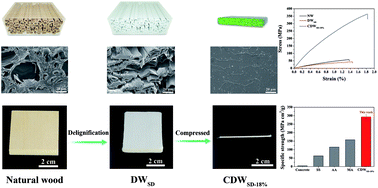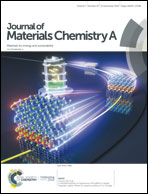Hydrogen-bonding-induced assembly of aligned cellulose nanofibers into ultrastrong and tough bulk materials†
Abstract
Structural materials with exceptional strength and toughness are highly desirable in engineering applications. However, it remains a grand challenge to combine these two mutually exclusive mechanical properties into one body. Nature has excelled in designing strong and tough structures (such as nacre and bone) without using complicated molecules and processes, which has inspired us to design biomimetic materials. In this paper, we propose a simple yet universal mechanism for making strong and tough structural materials out of cellulose nanofibers by water molecules-induced hydrogen bonding. This method can convert natural wood into strong and tough bulk materials by a three-step process of delignification, drying-induced assembly, and water molecules-induced hydrogen bonding under compression. A tough and strong cellulose nanofiber bulk material was derived, showing simultaneously enhanced tensile strength (352 MPa vs. 56 MPa for natural wood) and toughness (4.1 MJ m−3vs. 0.42 MJ m−3 for natural wood). The mechanical properties and morphological characteristics are greatly affected by water molecules within the structure during both drying and compressing and it has proved that water molecules can assist the assembly of cellulose nanofibers by participating in hydrogen bonding as structural molecules. This paper also provides important information for understanding the mechanisms used by nature to design structural materials, and is expected to guide the design of biomimetic materials.



 Please wait while we load your content...
Please wait while we load your content...